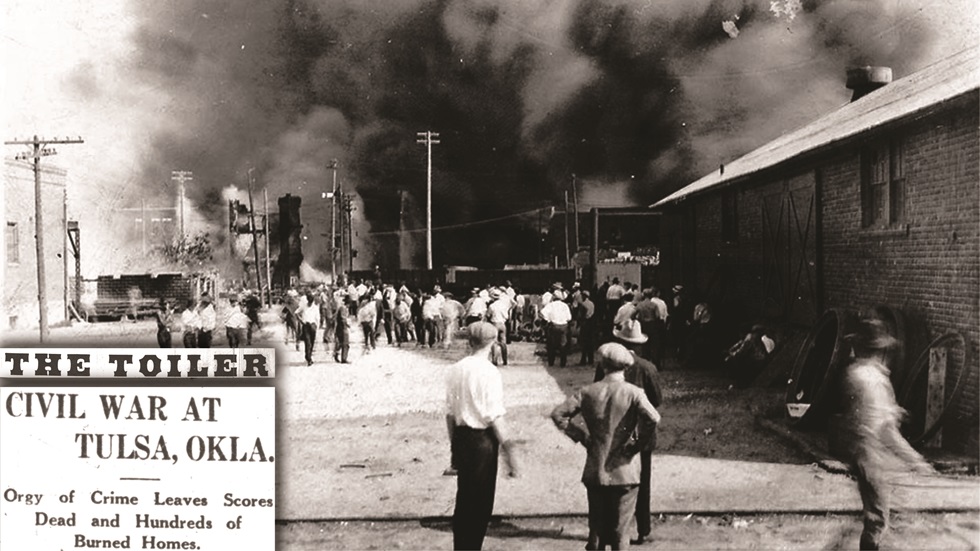
This article is part of the People’s World 100th Anniversary Series.
From the evening of May 31 through June 1, 1921, the Black neighborhood of Greenwood in Tulsa, Okla., was ravaged by white supremacist mobs. The infamous “Tulsa race riot,” more accurately described as the “Tulsa race massacre,” saw as many as 300 Black residents killed, hundreds of homes destroyed, and an entire neighborhood wiped from the map.
The event was sparked the day before, on May 30. Dick Rowland, a Black shoe shiner, was riding the Drexel Building elevator with Sarah Page, a white elevator operator, to use the segregated bathroom on the second floor, as he did every day. When the elevator returned to the ground floor, someone claimed to hear the young woman scream.
The local Tulsa Tribune newspaper had been raving about Greenwood for months, blaming the area for all the vices of Tulsa. It was a thriving community of 15,000 people with 191 businesses, so prosperous that it was referred to as the “Black Wall Street.” As it turns out, the Tribune was fronting for the real estate industry in its campaign against Greenwood. Tulsa was a booming oil town and developers were determined to drive out Black residents and seize the property, which they subsequently did.
When Rowland was arrested on May 31, the Tribune ran a front-page editorial headlined, “To Lynch Negro Tonight.” On cue, an armed white mob started marching toward the courthouse. Black men, some of them armed, marched from Greenwood to protect Rowland. Words were exchanged, and shots were fired. Several men fell dead.
The outnumbered Black defenders retreated back into Greenwood, pursued by the mob. Instead of intervening to stop the attackers, however, the Tulsa police deputized hundreds of Ku Klux Klansmen who then crossed the tracks into Greenwood, setting homes and shops afire and shooting many residents. The siege continued throughout the night and into the following day. Air attacks were even part of the siege, with men shooting rifles from planes and dropping firebombs.
Tulsa authorities made no effort to extinguish the fires that burned for hours until nearly every building was destroyed. About 1,200 structures were looted and destroyed. Eventually, the National Guard arrived to restore order, but soldiers reportedly had to spend much of their time collecting the bodies of the murdered residents of Greenwood. More effort was spent policing survivors than perpetrators; under martial law, as many as 6,000 Black Tulsans were rounded up and imprisoned in detention centers.
In reaction to bad press from other areas of the country, local officials conducted what amounted to a sham investigation and initially pledged to rebuild Greenwood. Those promises were all broken. Much of the land that had made up Greenwood was used to build a giant train terminal. As for Rowland, Page never pressed charges against him, and he eventually disappeared, though he was known to have lived into the 1960s or ’70s.
The Tulsa massacre was one incident in a long list of white supremacist atrocities that occurred during the years following World War I. William Z. Foster, Communist Party leader, wrote in his book, The Negro People in American History:
“In this period, many cities were afflicted with pogroms against the Negroes. These were called ‘race riots,’ but in actuality, they were deliberately planned, organized attacks against the Negro people by armed thugs in the service of the planter-monopolist reaction.”
Though the Tulsa massacre garnered significant national media attention at the time, discussions of the event quickly faded from the headlines, and officials in Oklahoma spent decades trying to erase the crime from memory.
The editorial below is something different for the People’s World 100th Anniversary Series. It appeared in the June 11, 1921, issue of The Toiler, a newspaper published by the Communist Labor Party before its eventual merger with the Communist Party of America to form the Communist Party USA. The Toiler is a forerunner of the Daily Worker, which later became People’s World.
As it was published in the immediate aftermath of the violence in Tulsa, it does not have the benefit of hindsight to know that the city would renege on all its promises to rebuild Greenwood and pursue justice. Nor did its writers know the details of the real estate industry’s scheming in advance of the attack. The editorial is written in the terminology of its day and does not yet feature the more sophisticated analysis of Black oppression in the U.S. which would be developed by later Marxists.
The Toiler, however, distinguished itself for being one of the few news outlets at the time to link race hatred to the profit system of capitalism, and it expressed the growing consciousness of early U.S. Communists that the struggles of the African American people and the working class as a whole were inseparably intertwined.
Civil War at Tulsa, Okla.
Orgy of Crime Leaves Scores Dead and Hundreds of Burned Homes
The Toiler – June 11, 1921
America’s weekly race riot between American-born Negroes and American- and foreign-born whites was carried off on scheduled time but on a considerably larger scale and with more elaborate trimmings than usual last week.
The moving finger of the American race war moves in planless fashion, now South, now North, now East, now West, leaving behind in letters of blood the story of a cultivated race prejudice which was born in the days when whites held Blacks in slavery; and which has been fanned into burning conflagrations by the sinister teachings of a white capitalist class civilization.
Last week, the finger stopped at Tulsa, Oklahoma. There, it wrote in blood and fire an indictment of the criminality of “Christian Civilization” that will stand as a monument to the spirit of Mob Rule as long as the city of Tulsa and its civilization shall stand.
Nearly a hundred dead, 7,000 homeless, 10 blocks of burned Negro homes, a property loss of a million-and-a-half dollars; these with a population debauched by crime, fear, and hate stand out as the results of a race war that is becoming more chronic with each passing year.
An accusation of a crime against a white girl by a Negro was the spark that set off the reign of terror at Tulsa. It raged for a day and a night before state troops gained control of the situation.
Now Tulsa is seeking to regain its “prestige” by a grand jury investigation, rebuilding the destroyed Negro homes, and otherwise cleansing its moral and physical countenance.
But the dead are dead. Now the finger will move on to fresh killings.
We hope you appreciated this article. At People’s World, we believe news and information should be free and accessible to all, but we need your help. Our journalism is free of corporate influence and paywalls because we are totally reader-supported. Only you, our readers and supporters, make this possible. If you enjoy reading People’s World and the stories we bring you, please support our work by donating or becoming a monthly sustainer today. Thank you!









